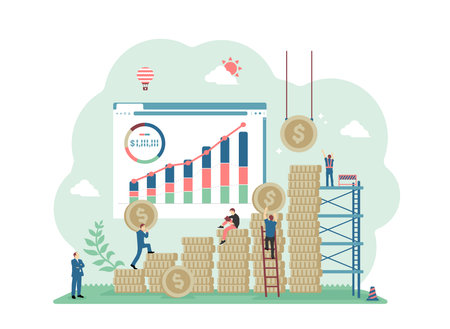1. Introduction to Hedge Funds
Hedge funds are a unique and influential segment of the U.S. financial markets, known for their flexible investment strategies and pursuit of absolute returns. Unlike traditional mutual funds, hedge funds operate with fewer regulatory constraints, allowing them to use leverage, short selling, derivatives, and other complex instruments to capitalize on market inefficiencies. Structurally, most hedge funds are organized as limited partnerships or limited liability companies, where fund managers serve as general partners and investors as limited partners. This structure enables fund managers to make swift investment decisions and adapt quickly to changing market conditions. In the broader context of U.S. financial markets, hedge funds play several key roles: they provide liquidity by actively trading in various asset classes; they enhance price discovery through sophisticated analysis and arbitrage strategies; and they often act as early adopters of innovative financial products. As a result, hedge funds not only seek alpha for their clients but also contribute to the overall dynamism and complexity of the American financial ecosystem.
Traditional Perspectives on Market Volatility
When analyzing the role of hedge funds in market volatility, it is essential to first understand traditional theories and the main drivers behind price swings in U.S. equities and derivatives markets. Classic financial theory often attributes market volatility to a combination of fundamental, technical, and behavioral factors. For decades, economists have studied how macroeconomic data releases, corporate earnings announcements, geopolitical events, and changes in monetary policy can create significant shifts in asset prices. These traditional perspectives emphasize that volatility is not a new phenomenon—rather, it is an inherent feature of efficient markets responding to new information.
In the context of U.S. markets, several common sources of volatility are routinely observed:
| Source of Volatility | Description |
|---|---|
| Economic Indicators | GDP growth rates, unemployment figures, and inflation data can all influence investor sentiment and drive sharp market moves. |
| Corporate Earnings | Quarterly results and guidance from large-cap companies can trigger both sector-specific and broad-based volatility. |
| Federal Reserve Policy | Interest rate decisions and comments by Fed officials frequently lead to re-pricing across asset classes. |
| Geopolitical Events | Trade tensions, elections, or global crises introduce uncertainty and sudden market reactions. |
| Technical Factors | Algorithmic trading, margin calls, and stop-loss orders can amplify short-term moves unrelated to fundamentals. |
The Efficient Market Hypothesis (EMH), a cornerstone of classical finance, argues that all available information is quickly reflected in securities prices, resulting in random but explainable price fluctuations. However, critics point out that real-world markets are prone to episodes of excessive optimism or pessimism—so-called “animal spirits”—that cannot be justified by fundamentals alone. Behavioral economics further expands this view by highlighting cognitive biases such as herding behavior and overreaction as critical contributors to volatility. In summary, while traditional perspectives lay a strong foundation for understanding why markets fluctuate, they also acknowledge the complexity introduced by human psychology and modern trading technologies.

3. How Hedge Funds Influence Volatility
Hedge funds are often at the center of debates about market volatility due to their use of sophisticated strategies and significant capital flows. One of the most prominent ways hedge funds impact price dynamics is through leverage. By borrowing capital to increase their market exposure, hedge funds amplify both potential gains and losses, which can intensify price swings in underlying assets. During periods of market stress, leveraged positions may be unwound rapidly, contributing to sharp, sudden movements in asset prices.
Short selling is another strategy that allows hedge funds to profit from declining markets. While this can provide liquidity and facilitate more accurate price discovery, aggressive short selling can exacerbate downward momentum during sell-offs. This was evident during events like the 2008 financial crisis and the more recent GameStop short squeeze, where collective hedge fund activity played a pivotal role in amplifying volatility.
High-frequency trading (HFT), increasingly adopted by quantitative hedge funds, also shapes intraday volatility. These funds use complex algorithms to execute trades at lightning speed, seeking to capitalize on minute price inefficiencies. Although HFT can enhance liquidity and tighten bid-ask spreads, it may also lead to abrupt spikes in volatility, especially during periods of market uncertainty or technical glitches—such as the notorious “Flash Crash” of 2010.
Taken together, these strategies—leverage, short selling, and high-frequency trading—underscore the dual role of hedge funds as both providers of liquidity and catalysts for heightened volatility. Their actions can ripple across markets, impacting institutional investors and everyday Americans alike by influencing asset prices in everything from retirement accounts to college savings plans.
4. Case Studies: Hedge Funds and Volatile Episodes
To better understand the influence of hedge funds on market volatility, it is crucial to examine their behavior during key periods of financial turmoil in the U.S. Two landmark events stand out for their scale and impact: the 2008 financial crisis and the 2020 COVID-19 sell-off. A data-driven analysis of these episodes sheds light on how hedge funds can both amplify and mitigate volatility, depending on their strategies and market positioning.
2008 Financial Crisis: Liquidity Crunch and Systemic Risk
The collapse of Lehman Brothers in September 2008 triggered a global liquidity crisis. During this period, hedge funds faced significant redemption pressures, forcing them to rapidly unwind leveraged positions. This mass deleveraging contributed to sharp declines in asset prices across equities, credit markets, and even traditionally safe assets like Treasuries.
| Key Metrics | Pre-Crisis (Q2 2008) | Post-Lehman (Q4 2008) |
|---|---|---|
| Average Hedge Fund Leverage | 2.1x | 1.4x |
| S&P 500 Drawdown (%) | -10% | -38% |
| Redemption Requests (% of AUM) | 5% | 20%+ |
The forced selling by hedge funds created a feedback loop, intensifying price swings and spreading risk throughout the financial system. However, some macro and relative value hedge funds were able to profit from dislocations, providing liquidity where traditional players withdrew.
2020 COVID-19 Sell-Off: Volatility Spikes and Tactical Positioning
The onset of the COVID-19 pandemic in March 2020 saw unprecedented market volatility, with the CBOE Volatility Index (VIX) spiking above 80—levels unseen since 2008. Many hedge funds initially suffered steep losses as correlations across asset classes soared and liquidity dried up.
| Key Metrics | February 2020 | March 2020 |
|---|---|---|
| Hedge Fund Composite Returns (%) | -0.6% | -9.5% |
| S&P 500 Drawdown (%) | -8% | -34% |
| VIX Peak Level | 25 | 82 |
Despite early setbacks, certain hedge fund strategies—such as global macro and quantitative—were able to adapt quickly, using short positions, options, and algorithmic trading to manage risk or exploit inefficiencies. In some cases, these funds provided much-needed liquidity when other investors retreated.
Comparative Insights: Crisis vs. Recovery Phases
| Crisis Phase Impact | Recovery Phase Role |
|---|---|
| Amplified volatility through rapid deleveraging and fire sales; contributed to systemic risk. | Acted as liquidity providers; captured alpha from dislocations; facilitated price discovery. |
| Suffered from correlated losses as market stress peaked. | Diversified strategies allowed for faster adaptation post-shock; often outperformed traditional managers during recovery. |
Summary of Data-Driven Findings
The data reveals that hedge funds are not monolithic actors in periods of volatility. Their collective actions can exacerbate market swings when leverage unwinds en masse but can also stabilize markets by supplying liquidity and capitalizing on inefficiencies during recoveries. The dual role underscores the complexity of hedge funds’ influence on U.S. market volatility over different market cycles.
5. Regulatory Landscape and Oversight
The regulatory environment for hedge funds in the United States has evolved significantly over the past few decades, especially as these investment vehicles have become more influential in driving market dynamics. Unlike mutual funds, hedge funds operate with greater flexibility, often utilizing leverage, short selling, and derivatives—tools that can amplify both returns and risks, including market volatility. Recognizing these risks, U.S. regulators have implemented a series of frameworks aimed at monitoring and overseeing hedge fund activities.
Key Regulatory Bodies and Laws
The primary oversight of hedge funds falls under the Securities and Exchange Commission (SEC), guided by laws such as the Investment Advisers Act of 1940. After the 2008 financial crisis exposed systemic vulnerabilities, the Dodd-Frank Wall Street Reform and Consumer Protection Act mandated that most hedge fund managers register with the SEC. This registration requires regular disclosures regarding their holdings, risk exposures, and trading strategies—steps intended to enhance transparency and reduce the likelihood of unchecked risk-taking that could spill over into broader markets.
Efforts to Curb Excessive Volatility
To further address concerns about excessive market volatility, U.S. regulators have implemented reporting requirements such as Form PF (Private Fund), which compels large hedge fund advisers to provide detailed data on assets under management, leverage levels, and counterparty exposures. The goal is to give regulators a clearer picture of potential concentrations of risk that could destabilize markets during periods of stress or rapid deleveraging.
Ongoing Policy Debates
Despite these measures, debate continues within policy circles about whether current regulations sufficiently mitigate systemic risk. Critics argue that some hedge funds remain opaque due to exemptions for smaller managers or international entities. Others contend that overly stringent rules could stifle innovation or drive capital offshore. As algorithmic trading and complex derivatives gain prominence among hedge funds, lawmakers are also considering updates to existing frameworks to keep pace with technological advances and evolving market structures.
In sum, while U.S. regulatory efforts have made significant strides in bringing hedge fund activities into greater public view and reducing potential triggers of market volatility, the balance between fostering financial innovation and safeguarding market stability remains a dynamic—and sometimes contentious—policy challenge.
6. Long-Term Market Impact and Policy Implications
Hedge funds, by virtue of their size, strategies, and leverage, exert a persistent influence on market stability and liquidity. While their active trading can enhance short-term price discovery and efficiency, the long-term implications are more nuanced. Over extended periods, hedge funds may contribute to both stabilization—through arbitrage and risk absorption—and destabilization, particularly when crowded trades unwind or when highly leveraged positions amplify systemic shocks.
Enduring Influence on Market Stability
Empirical data from the past two decades indicate that hedge funds often serve as liquidity providers during normal market conditions. However, during periods of stress, such as the 2008 financial crisis or the March 2020 liquidity crunch, their rapid deleveraging has at times exacerbated volatility. Studies from institutions like the Federal Reserve highlight that while hedge funds’ aggregate market impact is usually moderate, specific episodes reveal vulnerabilities in market microstructure linked to their activities.
Liquidity Dynamics: A Double-Edged Sword
Hedge funds’ ability to move quickly in and out of positions supports market liquidity under most circumstances. Yet, when many funds pursue similar quantitative strategies or react simultaneously to macro events, this liquidity can evaporate rapidly. For instance, in the U.S. Treasury market “flash rally” of October 2014, research suggests hedge fund unwinding contributed to unusual price movements and temporary illiquidity.
Potential Reforms and Forward-Looking Considerations
In response to these dynamics, regulators and policymakers continue to assess reforms aimed at enhancing transparency and systemic resilience. Proposals include increased reporting requirements for large hedge fund exposures, stress testing for liquidity mismatches, and closer scrutiny of leverage via derivatives. The Securities and Exchange Commission (SEC) and Commodity Futures Trading Commission (CFTC) have both signaled interest in strengthening oversight without stifling innovation or beneficial risk-taking.
Looking ahead, the evolving role of hedge funds will likely intersect with broader financial trends—including the rise of algorithmic trading, new sources of capital inflows (such as pension funds), and global interconnectedness. Ensuring that these vehicles can support efficient markets while minimizing systemic risks remains a balancing act for policymakers. Ultimately, a robust regulatory framework—combined with industry best practices—will be essential for preserving both market stability and the benefits hedge funds bring to American capital markets over the long term.

